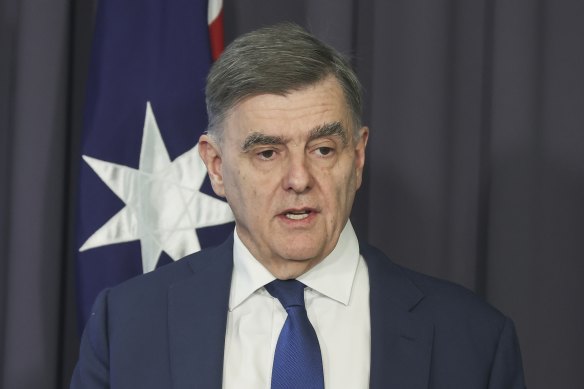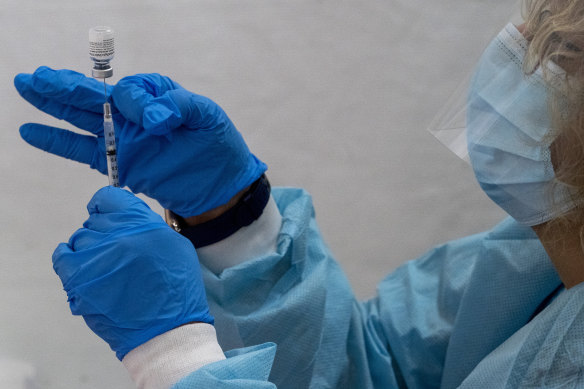This was published 4 years ago
A sixth of Australia’s vaccine supply at risk due to syringe shortage
By Mary Ward
Syringes designed to extract the maximum number of doses from Australia’s shipments of coronavirus vaccines will not be available when the national rollout begins on Monday.
Instead, federal Department of Health Secretary Brendan Murphy said low dead space syringes – which are designed to minimise waste in the injection process – were still on order amid a worldwide shortage, as NSW announced it was budgeting to lose up to a sixth of its supply in distribution.

Department of Health Secretary Brendan Murphy on Thursday.Credit: Alex Ellinghausen
“We have told NSW Health we won’t hold them to getting six doses out of each vial; they will try their best, as will all vaccination providers,” Professor Murphy said on Thursday, adding there were low dead space syringes on order due to arrive “in coming weeks”.
“We’re not confirmed yet. But these [standard] syringes are absolutely fine and many providers in the world are getting six doses most of the time.”
Low dead space syringes are designed to waste less fluid by ensuring the shape of the plunger beneath the metal needle fits into the neck of the syringe, leaving less fluid behind when the vaccine is administered.
On Wednesday, NSW Chief Health Officer Kerry Chant said her state was basing rollout estimates on extracting five doses from each vial of the Pfizer/BioNTech vaccine, not the labelled six, because standard syringes were being used.

A pharmacist fills a dead volume syringe with the Pfizer-BioNTech COVID-19 vaccine.Credit: AP
The estimate means NSW is prepared to waste 7000 doses to achieve the 35,000 it plans to administer over the next three weeks.
“While there is a possibility to get six doses out of each vial, that’s really contingent on us getting access to low dead space volume needles,” Dr Chant said.
The office for the Victorian Minister for Health and the federal Health Department were unable to confirm on Thursday evening if the syringe shortage would also affect the Victorian vaccine roll-out.
But Professor Peter Collignon – who sits on the federal Infection Control Expert Group – said the global shortage would likely be an issue for all states and territories.
Victorian-based epidemiologist Professor Mike Toole from the Burnet Institute also speculated Victoria would see wastage, but said it was standard practice for up to 20 per cent of vaccines to be discarded during polio and whooping cough inoculation programs.
“I know this particular vaccine, we don’t want any wastage but if we can keep wastage to less than five per cent [that’s OK],” he said.
Federal Health Minister Greg Hunt said NSW was being “cautious and conservative as they should be”.
“When we ordered, we based it on the foundation of five, and more than that is a bonus: it’s not the other way round,” he added.
There are major shortages of the low dead space syringes being reported overseas, including in Japan and the US, as countries race to vaccinate their populations against coronavirus.
Infectious diseases physician and associate professor at the University of Queensland Paul Griffin said low dead space syringes were usually only used in “unique” situations.
“For example, IVF transfers where we can’t afford to have anything left behind.”
However, they have become important for coronavirus vaccines packaged in multi-use vials. Most vaccines Australians receive are packaged in single-use vials, where the dose provided is exact for one patient.
“It only happens when we have no other choice,” Dr Griffin said of the multi-use vials, adding that he believed the current approach of proceeding with standard syringes was “justified”.
“It is ideal to get that low dead space syringe, but in circumstances like this it is just a time thing.”
At a parliamentary inquiry earlier this month, Professor Murphy admitted the multi-use vials were “a significant cause of risk and anxiety” due to Australia’s lack of experience.
A 2019 World Health Organisation guidance document found 10-dose vials, like those that will contain the AstraZeneca vaccine, have wastage rates between 15-25 per cent compared to a 5 per cent wastage rate from single-dose vials.
With Rachael Dexter
Get our Coronavirus Update newsletter
Stay across the news you need to know related to the pandemic. Sent Monday and Thursday. Sign up here.